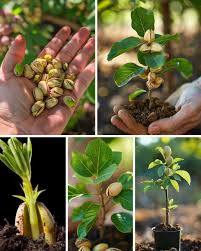Pistachios are renowned for their crunchy texture and rich, unique flavor, making them a beloved snack. These nutrient-dense nuts are not only tasty but can also be grown at home with a little patience and dedication. While the process is detailed and time-consuming, the reward of homegrown pistachios is well worth the effort. Here’s a clear, step-by-step guide to help you grow pistachios from seed.
1. Preparing to Plant:
Select Fresh Seeds: Begin by sourcing high-quality, untreated, and unroasted pistachio seeds. It’s best to obtain seeds from raw pistachios, as processed ones may not germinate. Ensure that the seeds are fresh for better germination success.
Cold Stratification: Pistachio seeds require a period of cold stratification to trigger germination. Place the seeds in a sealed plastic bag with moist sand, and store them in the refrigerator for about 6-8 weeks. This process simulates winter conditions and breaks the seed’s dormancy.
2. Germination:
After stratification, it’s time to plant your seeds. Use a well-draining soil mix and plant each seed about 1 inch deep. Ensure that the soil remains consistently moist but not soggy, as excess moisture can lead to rot. Maintain a temperature of around 70°F (21°C) to promote germination, which can take 4-6 weeks.
3. Transplanting:
Once your seedlings reach about 4-6 inches tall, they are ready to be transplanted. Pistachio trees require ample space, so choose large containers if growing indoors or in a greenhouse. A pot with good drainage is crucial to avoid waterlogging.
4. Choosing the Right Location and Soil:
Location: Pistachio trees thrive in full sunlight. Select a location that receives at least 6-8 hours of direct sunlight each day.
Soil: These trees prefer well-draining, alkaline soil. If your soil is heavy or acidic, amend it with organic matter, such as compost, to improve both drainage and nutrient levels. Consider testing your soil’s pH to ensure it falls within the ideal range of 7.0 to 8.0.

. Ongoing Care:
Watering: While pistachio trees are drought-tolerant once mature, they require regular watering in their early years. Ensure the soil remains moist but not soggy, as overwatering can cause root rot.
Pruning: Regular pruning helps maintain the shape of the tree and removes any dead or diseased branches, promoting healthier growth.
Fertilization: Use a balanced fertilizer to support strong development, paying special attention to zinc levels. Pistachios have a high zinc requirement, which is vital for their overall health and nut production.
6. Pollination:
Pistachio trees are dioecious, meaning there are separate male and female trees. To produce nuts, you’ll need at least one male tree to pollinate the females. Planting several seeds increases the chances of having both male and female trees, boosting your chances of successful pollination.
7. Harvesting:
Pistachios take time to bear fruit, typically 5-7 years after planting. Harvest your pistachios when the shells split open and turn a reddish-brown color. Carefully remove the soft outer hulls and allow the nuts to dry in a cool, shaded area for a few days to ensure they are fully dried before storage.
8. Pest and Disease Management:
Watch for pests such as aphids and caterpillars, and keep an eye out for diseases like botryosphaeria panicle and shoot blight. Organic pesticides, combined with good tree hygiene, can help prevent infestations and keep your trees healthy.
Conclusion:
Growing pistachios from seed at home is a rewarding journey that requires patience, careful attention, and a commitment to nurturing your plants. While it may take several years for your trees to bear fruit, the experience of watching them grow and eventually harvest your own pistachios is immensely satisfying. Whether you’re a beginner or a seasoned gardener, growing pistachios can deepen your connection to nature and help develop resilience in your gardening practices.
